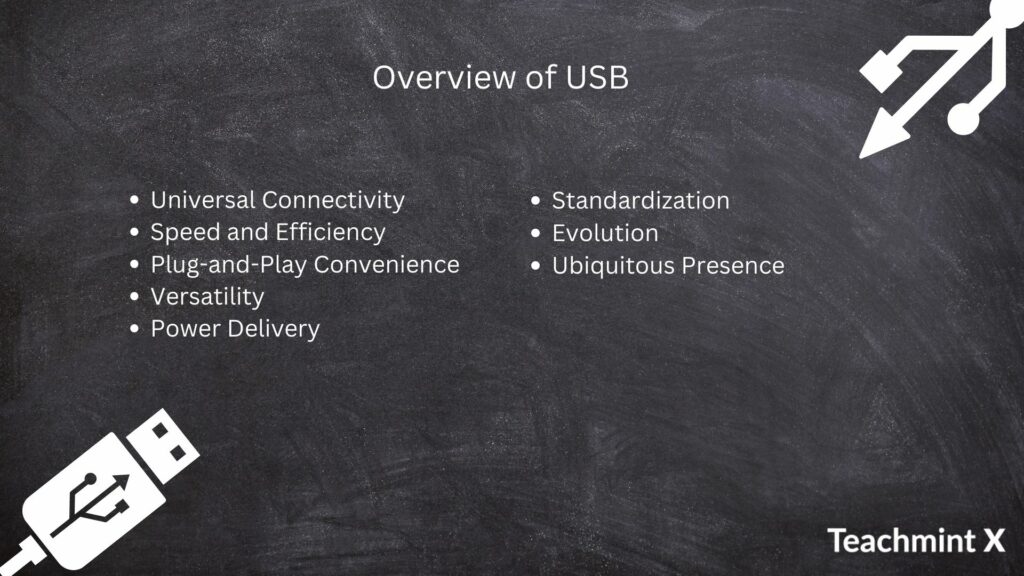Introduction:
USB full form is a Universal Serial Bus, it has revolutionized the way we connect and interact with electronic devices. Its versatility, reliability, and ease of use have made it a ubiquitous standard in the realm of technology. This article explores the unknown advantages of USB, its objectives, and its evolution over the years.
Advantages of USB:
- Universal Compatibility: As the USB full form says it has universal compatibility across a vast array of devices, including computers, smartphones, tablets, gaming consoles, printers, cameras, and more.
- Plug-and-Play Functionality: USB offers plug-and-play functionality, allowing users to connect devices without the need for complex setup procedures or the installation of additional drivers.
- Hot Swapping: USB supports hot swapping, enabling users to connect and disconnect devices while the host device is powered on. This feature facilitates convenient device replacement and expansion without the need for system restarts, enhancing productivity and flexibility.
- Data Transfer Speeds: USB technology has evolved over the years to support increasingly faster data transfer speeds.
- Power Delivery: USB not only allows the data transfer feature but it also helps in power delivery. It can eliminate the use of any unnecessary adapters which are not necessary. USB can be used to charge low-end devices.
- Versatility: USB supports a wide range of functionalities beyond data transfer and power delivery. It also helps in connecting other types of devices including keyboards, mice, external storage drives, audio interfaces, and virtual reality (VR) headsets. This versatility makes USB indispensable in both consumer and professional settings.
- Cost-Effectiveness: USB technology offers a cost-effective solution for connectivity and peripheral integration. USB provides cost-effective solutions which can be used for many purposes. It saves a lot of cost in terms of any third-party solution or hardware requirement.
Objectives of USB:
- Standardization: The primary objective of USB is to establish a standardized interface for connecting peripherals and devices across different platforms and operating systems. This standardization promotes interoperability, simplifies integration, and enhances user convenience.
- Simplified Connectivity: USB aims to simplify the process of connecting devices by offering a plug-and-play interface that eliminates compatibility issues and reduces the complexity of setup procedures. This objective ensures seamless connectivity and enhances user experience.
- Scalability: USB is designed to accommodate evolving technology trends and user requirements by supporting scalability in terms of data transfer speeds, power delivery capabilities, and device compatibility. This scalability enables USB to adapt to the changing landscape of technology and meet the needs of diverse applications.
- Accessibility: USB helps to make technology more accessible to users by providing a common interface that is easy to use, widely available, and compatible with a broad range of devices. This enables users to create new solutions and use the devices much more effectively
- Innovation: USB creates innovation by providing a platform for the development of new technologies, and applications. The ongoing evolution of USB standards, such as USB4 and USB PD, encourages innovation in areas such as high-speed data transfer, power efficiency, and connectivity solutions.

Evolution of USB:
Over the years USB has changed in many forms and improved the technology:
- USB 1.0: Found in 1996, USB 1.0 offered data transfer speeds of up to 1.5 Mbps (Low-Speed) and 12 Mbps (Full-Speed). It formed the foundation for universal transfer.
- USB 2.0: Launched in 2000, USB 2.0 increased data transfer speeds to 480 Mbps (High-Speed), significantly enhancing performance and efficiency. It became widely adopted in consumer electronics and computer peripherals.
- USB 3.0: This version of USB was released in 2008, it offered a high speed of 5gbps. This offered a much faster data transfer rate and helped in performing actions fast.
- USB 3.1: Introduced in 2013, USB 3.1 further improved data transfer speeds to 10 Gbps (SuperSpeed+), doubling the performance of USB 3.0. It also introduced the reversible Type-C connector, enhancing convenience and versatility.
- USB4: Announced in 2019, USB4 represents the latest advancement in USB technology, offering a single solution for both USB and Thunderbolt connectivity. USB4 supports data transfer speeds of up to 40 Gbps, along with backward compatibility with previous USB generations.
Conclusion:
The Universal Serial Bus (USB) has emerged as one of the biggest advantages of modern technology, offering universal compatibility, plug-and-play functionality, and versatile connectivity. With advantages, including universal compatibility, plug-and-play functionality, and versatile connectivity, USB continues to drive innovation and empower users in an increasingly connected world. As USB technology keeps on evolving, it will remain a key enabler of digital connectivity, powering the devices and applications of tomorrow.
Kindly explore the Website for more information.

